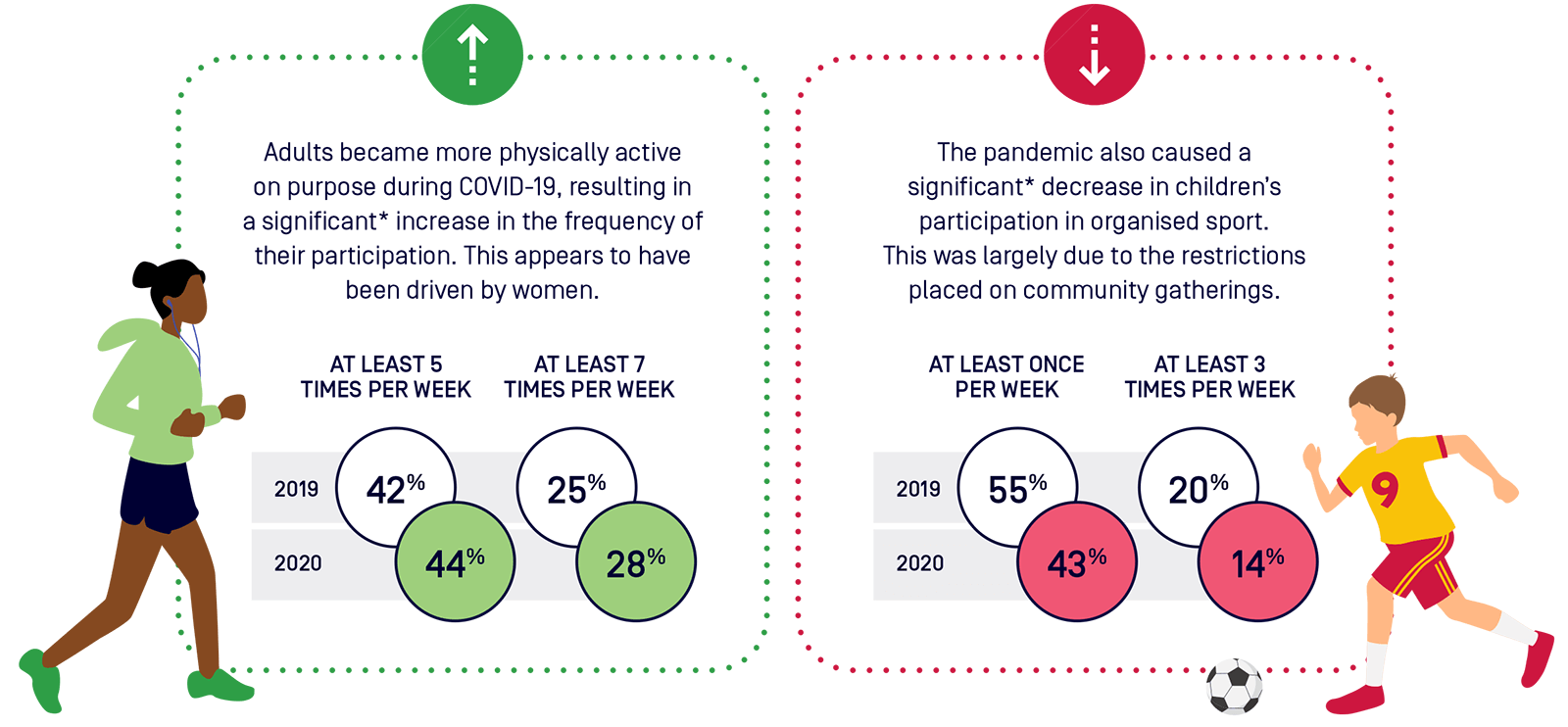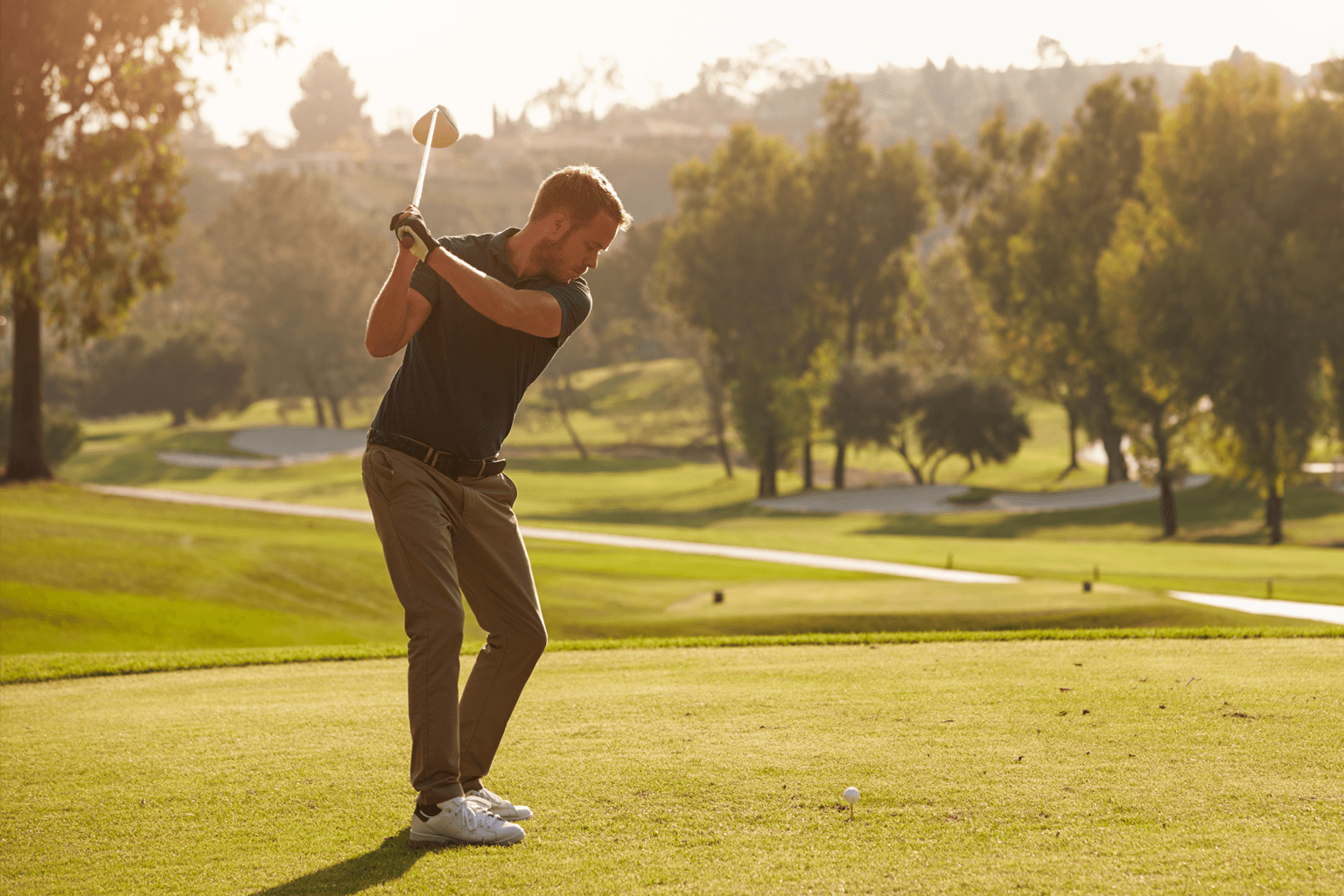25 June 2021
The impact of COVID-19 remains a deterrent when it comes to rates of participation in organised sport across Australia.

Text box with green arrow pointing up: Adults became more physically active on purpose during COVID-19, resulting in a significant* increase in the frequency of their participation. This appears to have been driven by women.
Table: At least 5 times per week, 42% (2019), 44% (2020); At least 7 times per week, 25% (2019), 28% (2020).
Text box with red arrow, pointing down: The pandemic also caused a significant* decrease in children's participation in organised sport. This was largely due to the restrictions placed on community gatherings.
Table: At least once per week, 55% (2019), 43% (2020); At least 3 times per week, 20% (2019), 14% (2020).
* Statistically significant change year-on-year.
- Children’s sport participation the most hit by the pandemic
- Women drive increase in adult participation
- Golf and tennis rally to record a significant increase
The impact of COVID-19 remains a deterrent when it comes to rates of participation in organised sport across Australia.
But the pandemic has driven up rates of participation in socially-distanced sports and recreational activities.
The findings have been revealed in the latest data from Sport Australia’s AusPlay and Community Perceptions Monitor surveys.
Sport Australia Acting CEO Rob Dalton said while the pandemic had resulted in a dip in participation for some sports, there had been a rise in others.
“While men drove the increases in golf, tennis, and mountain biking, women contributed more than men to the increases in walking, running, bush walking, swimming and yoga participation,” Mr Dalton said.
“Sports like golf and tennis, which were not as affected by lockdowns and restrictions have seen significant increases in overall participation over the past 12 months.”
An estimated 253,000 more Australian adults participated in golf in 2020 compared with 2019, while 185,000 more participants played tennis.
Mr Dalton said the research found 80 per cent of adults and children who played organised sport before COVID-19 had returned to at least one of their sports by March 2021.
However, restrictions on junior sport had resulted in the percentage of children who played organised sport outside of school at least once a week dropping from 55 in 2019 to 43 per cent in 2020.
“We know sport and physical activity is vital to the overall development of children and that’s why our Sporting Schools program is so important,” Mr Dalton said.
“It gives every Australian child the opportunity to get active and engaged through sport.”
Mr Dalton said AusPlay continues to be an important way to track how Australians engage with sport and physical activity, while the Community Perceptions Monitor survey captures public attitudes towards various aspects of sport.
The latest findings follow Sport Australia’s Early impact of COVID-19 on sport and physical activity participation report published in October last year.
Minister for Sport, Senator the Hon Richard Colbeck said he was confident sport will emerge from the pandemic in a strong position.
“The Australian Government, through Sport Australia, is getting on with the job of supporting sport,” Minister Colbeck said. “We recognise it will be a long recovery process for some and we remain committed to supporting sport through these uncertain times.”
He said the Government’s decision to extend the successful Sporting Schools program in Budget 2021/2022 was driven by its success over recent years, providing an additional $40.8 million to extend the program.
Additionally, the Government is committed to increasing opportunities for women’s participation in sport and support for elite female athletes.
“With one month to go until the Tokyo Olympics Opening Ceremony, it’s clear that sport continues to play an important role in the lives of all Australians and this report provides us with vital insights as sports look to attract and retain participants as we recover from COVID-19,” Minister Colbeck said.
What the data also shows
- Adults became more physically active on purpose during COVID-19, resulting in a significant increase in the frequency of their participation. This appears to have been driven by women.
- 44 per cent of Australians said they missed sport being in their life through the early phases of COVID-19.
- This had fallen to 30 per cent by Christmas and to 26 per cent by March 2021.
- The top reasons for adults not returning to organised sport include COVID-19 concerns (38 per cent), other commitments (36 per cent) or because organised sport was yet to re-start (31 per cent).
- The top reasons children hadn’t returned were primarily because junior competition had not re-started (37 per cent) and concerns about COVID-19 (31 per cent).
- By March 2021, 16 per cent of Australian adults and 23 per cent of children had started playing in a new organised sport for the first time since COVID-19.
- 53 per cent of adults who volunteered before COVID-19 were back volunteering by March 2021 compared with 30 per cent in August 2020.
- Five per cent of Australian adults had started volunteering in an organised sport for the first time since COVID-19 by March 2021. Their primary motivations for starting were wanting to do something for the community (44 per cent) and social reasons (35 per cent).
The full report is available via the Clearinghouse for Sport.
